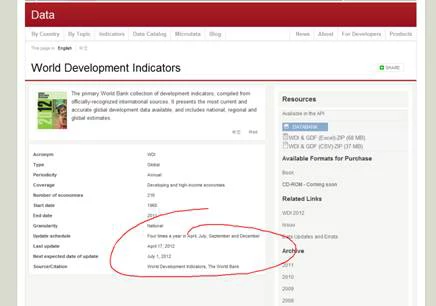This page in Spanish | French | Arabic | Chinese
When the World Bank opened its doors and launched the Open Data Initiative two years ago, our Data Help Desk was flooded with questions, requests and comments from students, researchers, journalists, economists, statisticians and more. The demand for our data has only grown, and right now, our team answers around a thousand data-related queries a month by email and phone.
 |
| Meet the World Bank Open Data Helpdesk Team |
This growing appetite for data keeps us on our toes: the Open Data team is constantly on the lookout for new data and sources; validating, compiling and curating data; designing tools to make data more usable - all the while answering your questions and using your feedback to improve our products.
If you ever wondered whether you’re the only one asking us about where to find historic country classifications, where to find GDP figures for the former Soviet Union or how to calculate changes in base year - the answer is - no, you are not alone. Every day dozens of users from around the globe contact us in search of answers to these and many other questions.
Following Tariq’s “Top 5 Ways to Access World Bank Data”, we decided to list the top 5 questions that we get asked at the Open Data helpdesk.
So, here we go, in no particular order:
1. How do you classify countries?
You can read a more complete answer here, but to summarize:
By income per capita
Our main classification criterion is gross national income (GNI) per capita. Based on its GNI per capita, every country is classified as low income, middle income (subdivided into lower middle and upper middle), or high income. These classifications get revised every year as of July 1st.
By Geographic region
Classifying countries geographically may seem straightforward, but it does occasionally need some extra explanation . For example, Djibouti while being a Sub Saharan African country, is classified under Middle East and North Africa (MENA), and Iran, which under the United Nations classification is listed under South Asia, the World Bank also classifies as MENA.
These regional aggregates and geographic regions are primarily for operational and administrative purposes, and since some countries do not have World Bank country offices, they are added to a neighboring country which could be a part of a different region.
Historical Income Classification
While there are pages we have on the site that list all the different income classifications, like the Country and Lending Groups Page, it’s often the historical data that the users are after. We actually have that too, and you can find it at the bottom of the Short History Page as an Excel spreadsheet.
2. How many times are the data revised or updated - and when?
Our statisticians and data quality experts work diligently to make sure that our data is as accurate as possible. Data in the World Development Indicators database comes from multiple sources, including agencies such as the United Nations and World Health Organization, and national statistical agencies in countries around the world.
We normally update World Development Indicators 4 times a year in April, July, September and December. Other datasets may be updated more or less frequently and information on update cycle scan be found in the Data catalog entries for each dataset.

We also publish a data updates and errata page to document major changes or revisions to previously published data.
3. Can I get GNI per capita (or any other indicator data) for a particular set of countries for certain years?
Sure you can. The best way to retrieve this data would be to use one of our data tools, like the indicator pages on the data site, which also has simple navigation to data by country or topic. For those comfortable with performing customized queries, the DataBank tool lets you create your own queries, generate tables, charts and maps and easily save, embed and share them.
We’ve also made a DataBank tutorial video and prepared some FAQs and instructions. If you’ve got any more questions, just contact us at data@worldbank.org – we’re always here to help.
4. Can you change the base year for the constant series and send me the data for say “Final consumption expenditure (constant 2000 US$)” with a different base year?
It’s actually pretty easy to do this yourself – you can find the information in the “About the Data” page. The explanation tells you how to rescale the 2000 base year to 1995, but the same procedure applies to adjusting the base year to any other year.
5. We would like to republish your data in our research/publication/website – whom should we contact and how much does it cost?
We encourage you to use our data in creative ways; all datasets listed in our data catalog (unless specifically noted) are covered by our terms of use. Provided you follow them, you don’t need to contact anyone or sign any contracts. They permit free commercial and non-commercial use and re-use of our data, provided they are correctly attributed. You can read the detailed version here.
So, these are the Top-5 questions that get asked by our open data users, look out for more soon!



Join the Conversation